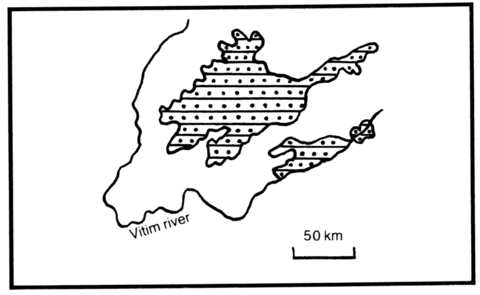stripes
On the Vitim Plateau basaltic flows extend over approximately 7,000 km2 (Fig. 204); this is the most extensive area of Cainozoic volcanic activity in the Baikal region. Miocene alkaline olivine basalts with subordinate basanites and pyroclastic rocks are the most abundant and fill tectonic depressions and river valleys with lava sequences 200-400 m thick (Ionov et al., 1993a). The youngest flows are Pliocene basanites and hawaiites. There are more than 20 volcanic centres of Miocene age and these consist of scoria cones with small lave flows. A single occurrence of alkali picritic tuff has been found. In the Dzhilinda Depression two volcanogenic-sedimentary series are present. The lower series is 200 m thick, of which the volcanic rocks comprise some 36%. The upper volcanogenic-sedimentary series is 150-160 m thick and volcanic rocks comprise more than 90%. At the bottom of the volcanic sequence mildly alkaline olivine basalts are about 3 m thick and are covered by 1 m of siltstones and a 4 m thick boulder bed. There follow two basanite layers with a total thickness of 38 m, which are succeeded by sandstones (23 m) and siltstones. There then follow three series consisting of basanites (90-100 m), basalts (50-60 m) and hawaiites (40 m). The final stage of the volcanic activity was the production of scoria cones which are about 80-90 m high. Small peridotite xenoliths and pyroxene megacrysts occur in both Miocene and younger basalts throughout the field. A very detailed account of these xenoliths, including analyses of the host rocks, is given by Ionov et al. (1993a).
*IONOV, D.A., ASHCHEPKOV, I.V., STOSCH, H.-G., WITT-EICKSCHEN, G. and SECK, H.A. 1993a. Garnet peridotite xenoliths from the Vitim volcanic field, Baikal region: the nature of the garnet-spinel peridotite transition zone in the continental mantle. Journal of Petrology, 34: 1141-75.
RASSKAZOV, S.V. and BATYRMURZA’E V, A.S. 1985. Cenozoic basalts from the Vitim Plateau and determination of their ages. Geologiya i Geofizika. Novosibirsk, 5: 20-7.

